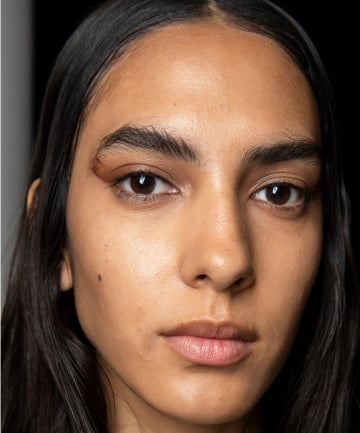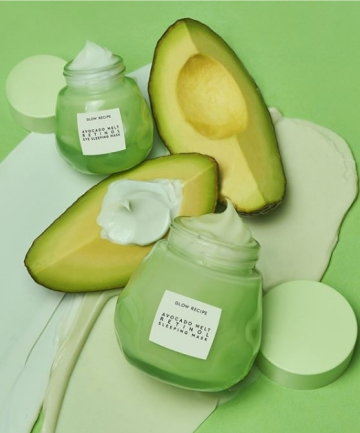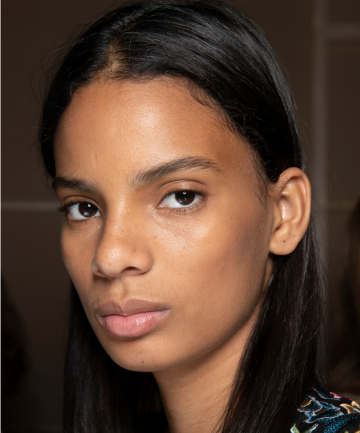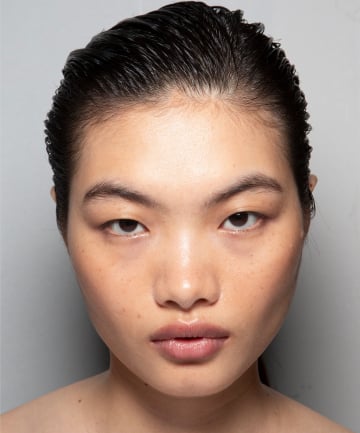Retinol wins for being potent and helping to slow down the march of time on skin, but it comes with side effects. Topical retinol can lead to redness, peeling, skin tenderness and sensitivity to the sun, according to Akridge. Glow Recipe co-founder and co-CEO Sarah Lee continues that in traditional formulas the potent ingredient is released all at once which can lead to irritation.
Another big issue is that like vitamin C retinol is light- and oxygen-sensitive, so it degrades readily, according to Prystowsky. If it's packaged in any old container that allows air and light to get in, the problem becomes worse... which is where encapsulation comes in.
Image via Imaxtree
Another big issue is that like vitamin C retinol is light- and oxygen-sensitive, so it degrades readily, according to Prystowsky. If it's packaged in any old container that allows air and light to get in, the problem becomes worse... which is where encapsulation comes in.
Image via Imaxtree
Encapsulating retinol cuts down exposure to air and light. As its name suggests, encapsulated retinol is delivered to skin in a "protected" capacity so it remains stable and potent for longer — we're talking on a microscopic level. The retinol is not in mini capsules that we rip open. Gohara says to think of a little submarine carrying retinol as its passenger to the parts of the skin where the active ingredient will be most effective.
Encapsulated retinol formulas slowly time release the active ingredient into skin instead of all at once on the skin's surface, like other retinol products. The benefit of encapsulated retinol is it is gentle but still potent. To continue with the metaphors, encapsulation offers a steady stream as opposed to a tidal wave of retinol.
Image via Imaxtree
Encapsulated retinol formulas slowly time release the active ingredient into skin instead of all at once on the skin's surface, like other retinol products. The benefit of encapsulated retinol is it is gentle but still potent. To continue with the metaphors, encapsulation offers a steady stream as opposed to a tidal wave of retinol.
Image via Imaxtree
There are various ways retinol can be formulated, including different encapsulation methods. Retinol could be added to a formula under an inert gas or suspended in liquid form. It could also be encapsulated in microsponge polymers, cellulose/sugar-based beads or in silicone. Akridge points out that each encapsulation method comes with many studies showing the benefits of that particular encapsulation.
For example, Eve Lom uses liposome-encapsulated retinol in its Time Retreat Radiance Essence, $95, and Time Retreat Intensive Night Cream, $140, to gently but effectively deliver anti-aging benefits. The Sunday Riley A+ High-Dose Retinoid Serum, $85, has an advanced strength retinoid serum that is liposomal-encapsulated.
Similarly, Lee says that Glow Recipe's Avocado Melt Retinol Sleeping Mask, $49, and Avocado Melt Retinol Eye Sleeping Mask, $42, have time-released technology and encapsulated retinol. Per Chang, the retinol is housed in a polysaccharide shell that gently breaks down as it's absorbed into skin. The shell releases retinol within skin in smaller amounts versus traditional freeform retinol, which immediately releases the full bang upon contact with skin.
Image via @glowrecipe
For example, Eve Lom uses liposome-encapsulated retinol in its Time Retreat Radiance Essence, $95, and Time Retreat Intensive Night Cream, $140, to gently but effectively deliver anti-aging benefits. The Sunday Riley A+ High-Dose Retinoid Serum, $85, has an advanced strength retinoid serum that is liposomal-encapsulated.
Similarly, Lee says that Glow Recipe's Avocado Melt Retinol Sleeping Mask, $49, and Avocado Melt Retinol Eye Sleeping Mask, $42, have time-released technology and encapsulated retinol. Per Chang, the retinol is housed in a polysaccharide shell that gently breaks down as it's absorbed into skin. The shell releases retinol within skin in smaller amounts versus traditional freeform retinol, which immediately releases the full bang upon contact with skin.
Image via @glowrecipe
Encapsulated retinol products generally keep light and oxygen away from the active ingredients until the formula is applied to skin which means it's more stable. (Think of the submarines.) Prystowsky says that this will help ensure potency of the product until each dose is used. That means users will get more consistent dosages, which is important in skin care, especially when using powerful ingredients. Gohara continues that encapsulated retinol will be able to penetrate deeper into skin since it is protected by an outer layer (the capsule) until it hits its destination. Then it can get to work fading wrinkles, preventing acne and boosting collagen production.
Image via Imaxtree
Image via Imaxtree
Encapsulation seems like a star method, but Akridge says that there are potential problems. He says that heat and light are still threats. (So, look for retinol products in dark bottles and/or tinted capsules. Prystowsky says do not store products near sunlight or radiators.)
Additionally, In some cases the capsule may be many times bigger than the retinol dosage so other nonactive ingredients could be added to the formula to "bulk it out." Akridge says that some of these ingredients could bind to retinol, rendering it less effective.
Another thing to consider? The potential break down of encapsulated retinol. It depends on the encapsulation method used; heat, time and production. Akridge says that some liposomes are fragile, so they are added in the last step of production. "If they survive production, and make it into the bottle intact, they sit there in a chemical mixture waiting for purchase, hoping they won't be exposed to heat or light," says Akridge. "The question I have is if the remaining liposome-encapsulated retinol makes it to your skin, is this concentration effective enough to do anything?"
If the encapsulation works, the encapsulated retinol should last longer than "regular" retinol, but it still doesn't last forever.
Image via Imaxtree
Additionally, In some cases the capsule may be many times bigger than the retinol dosage so other nonactive ingredients could be added to the formula to "bulk it out." Akridge says that some of these ingredients could bind to retinol, rendering it less effective.
Another thing to consider? The potential break down of encapsulated retinol. It depends on the encapsulation method used; heat, time and production. Akridge says that some liposomes are fragile, so they are added in the last step of production. "If they survive production, and make it into the bottle intact, they sit there in a chemical mixture waiting for purchase, hoping they won't be exposed to heat or light," says Akridge. "The question I have is if the remaining liposome-encapsulated retinol makes it to your skin, is this concentration effective enough to do anything?"
If the encapsulation works, the encapsulated retinol should last longer than "regular" retinol, but it still doesn't last forever.
Image via Imaxtree









